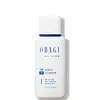What's inside
What's inside
 Key Ingredients
Key Ingredients

 Benefits
Benefits

 Concerns
Concerns

 Ingredients Side-by-side
Ingredients Side-by-side

Water
Skin ConditioningCocamidopropyl Betaine
CleansingSodium Lauroyl Oat Amino Acids
CleansingSodium Laureth Sulfate
CleansingGlycerin
HumectantAloe Barbadensis Sprout
HumectantGlycereth-7
HumectantPrunus Armeniaca Kernel Oil
MaskingPanthenol
Skin ConditioningAcrylates/C10-30 Alkyl Acrylate Crosspolymer
Emulsion StabilisingOleyl Lactate
EmollientEthoxydiglycol
HumectantTriethanolamine
BufferingSalvia Officinalis Extract
AntimicrobialBorago Officinalis Extract
EmollientPhenoxyethanol
PreservativeMethylparaben
PreservativePropylparaben
PreservativeEthylparaben
PreservativeButylparaben
MaskingSaponins
CleansingParfum
MaskingCI 19140
Cosmetic ColorantWater, Cocamidopropyl Betaine, Sodium Lauroyl Oat Amino Acids, Sodium Laureth Sulfate, Glycerin, Aloe Barbadensis Sprout, Glycereth-7, Prunus Armeniaca Kernel Oil, Panthenol, Acrylates/C10-30 Alkyl Acrylate Crosspolymer, Oleyl Lactate, Ethoxydiglycol, Triethanolamine, Salvia Officinalis Extract, Borago Officinalis Extract, Phenoxyethanol, Methylparaben, Propylparaben, Ethylparaben, Butylparaben, Saponins, Parfum, CI 19140
Water
Skin ConditioningCocamidopropyl Betaine
CleansingGlycerin
HumectantDecyl Glucoside
CleansingSodium Hydrolyzed Potato Starch Dodecenylsuccinate
Water, Cocamidopropyl Betaine, Glycerin, Decyl Glucoside, Sodium Hydrolyzed Potato Starch Dodecenylsuccinate, Sodium Chloride, Citric Acid, Sodium Benzoate, Potassium Acrylates Copolymer, Linoleamidopropyl Pg-Dimonium Chloride Phosphate, Disodium EDTA, Sodium Hydroxide, Chrysanthemum Parthenium Flower/Leaf/Stem Juice
 Reviews
Reviews

Ingredients Explained
These ingredients are found in both products.
Ingredients higher up in an ingredient list are typically present in a larger amount.
Cocamidopropyl Betaine is a fatty acid created by mixing similar compounds in coconut oil and dimethylaminopropylamine, a compound with two amino groups.
This ingredient is a surfactant and cleanser. It helps gather the dirt, pollutants, and other impurities in your skin to be washed away. It also helps thicken a product and make the texture more creamy.
Being created from coconut oil means Cocamidopropyl Betaine is hydrating for the skin.
While Cocamidopropyl Betaine was believed to be an allergen, a study from 2012 disproved this. It found two compounds in unpure Cocamidopropyl Betaine to be the irritants: aminoamide and 3-dimethylaminopropylamine. High-grade and pure Cocamidopropyl Betaine did not induce allergic reactions during this study.
Learn more about Cocamidopropyl BetaineGlycerin is already naturally found in your skin. It helps moisturize and protect your skin.
A study from 2016 found glycerin to be more effective as a humectant than AHAs and hyaluronic acid.
As a humectant, it helps the skin stay hydrated by pulling moisture to your skin. The low molecular weight of glycerin allows it to pull moisture into the deeper layers of your skin.
Hydrated skin improves your skin barrier; Your skin barrier helps protect against irritants and bacteria.
Glycerin has also been found to have antimicrobial and antiviral properties. Due to these properties, glycerin is often used in wound and burn treatments.
In cosmetics, glycerin is usually derived from plants such as soybean or palm. However, it can also be sourced from animals, such as tallow or animal fat.
This ingredient is organic, colorless, odorless, and non-toxic.
Glycerin is the name for this ingredient in American English. British English uses Glycerol/Glycerine.
Learn more about GlycerinWater. It's the most common cosmetic ingredient of all. You'll usually see it at the top of ingredient lists, meaning that it makes up the largest part of the product.
So why is it so popular? Water most often acts as a solvent - this means that it helps dissolve other ingredients into the formulation.
You'll also recognize water as that liquid we all need to stay alive. If you see this, drink a glass of water. Stay hydrated!
Learn more about Water